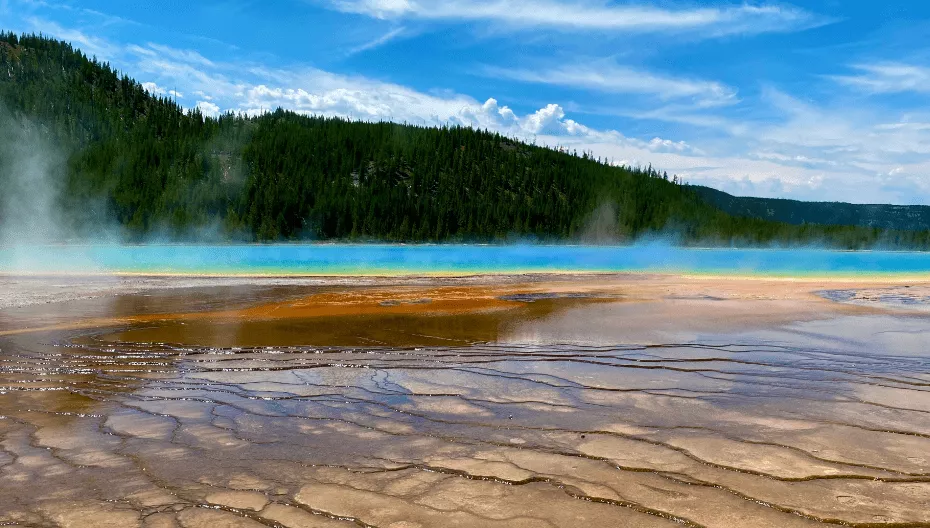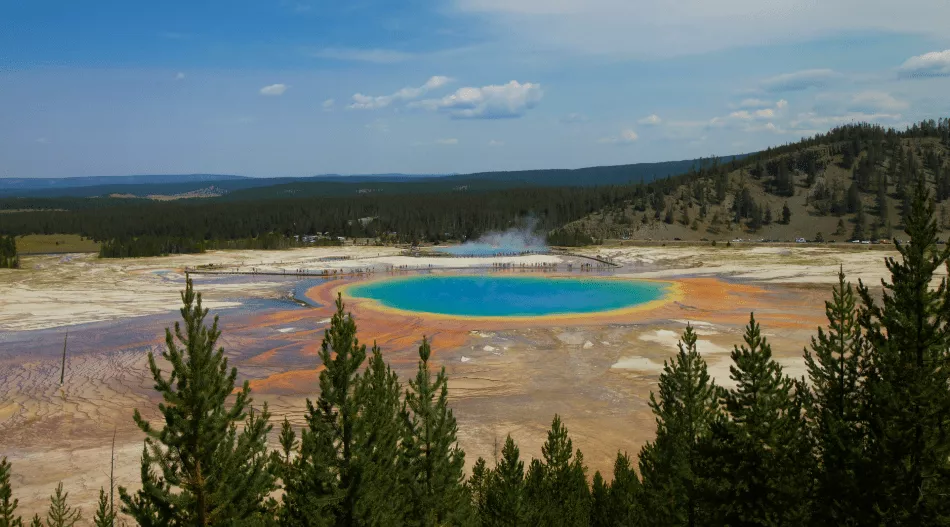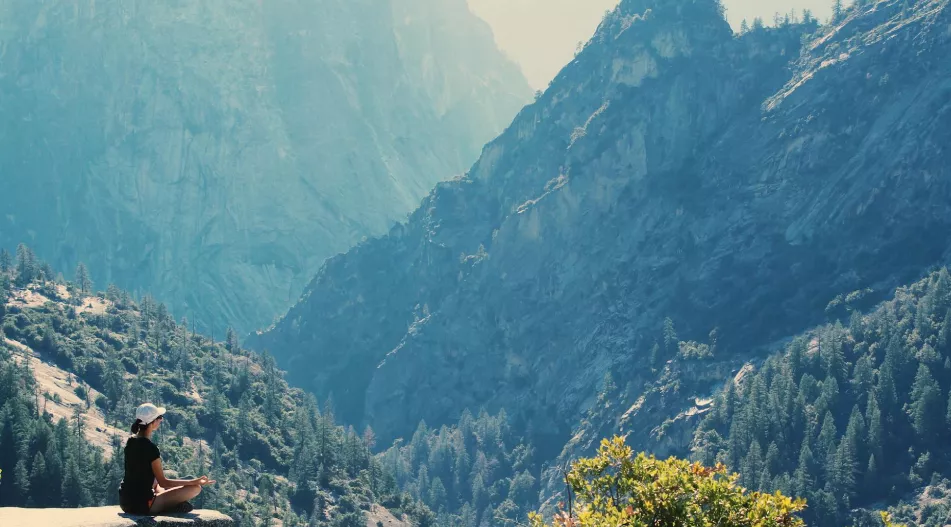Wyoming’s Yellowstone National Park is a trove of natural beauty and adventure. This park has everything, whether you want to hike through breathtaking scenery, see animals in their natural habitat, or just enjoy the unusual geological characteristics. Adventure awaits in Yellowstone National Park, Wyoming, with so much to see and do!
Everything You Need to Know
- Discover the magnificent mountains and lively hot springs.
- Watch for bison, elk, and other bird species.
- Select from hiking paths appropriate for all ability levels.
- Feel the excitement of river whitewater rafting.
1. Discover Breathtaking Landscapes
Yellowstone is a canvas created with nature’s greatest strokes, not only a park. Honestly, you could spend weeks just driving about and still not see anything. The size of the site alone is astounding. I recall the first time I visited; the beauty was so great and diverse I was completely unprepared. It’s not only geysers and animals; the majesty of the scenery really catches you.
Majestic Mountains and Valleys
The mountains in this area are truly impressive. They are serious. There are endless valleys that stretch out and towering summits that touch the sky. This type of view can make you feel small, but in a positive way. With its sharp peaks and alpine meadows, the Absaroka Range is especially breathtaking. Last summer I hiked up one of the paths; the view from the summit was incredible. You could see for kilometers in all directions. Though it’s a workout, it’s absolutely rewarding. Equally remarkable are the valleys chiseled down by ancient glaciers. They are teeming with all kinds of animals, woods, and rivers. To be honest, it’s a photographer’s fantasy.
Vibrant Hot Springs
Indeed, the hot springs are the focal point of the experience. These are not your typical swimming pools. We’re referring to pools filled with boiling water, bubbling muck, and vibrant hues. Probably the most renowned, and for good cause, is the Grand Prismatic Spring. The colors are crazy—bright blues, greens, yellows, and oranges all whirling together—and it’s enormous. It resembles peering into another planet. Still, all around the park are many more hot springs, each with its own distinct appearance and atmosphere. Keep your distance from these heated items. Here is a fast glance at many well-known hot springs:
- Grand Prismatic Spring
- Pool of Morning Glory
- Biscuit Basin
- Beautiful Falls
The waterfalls of Yellowstone are really underappreciated. While the waterfalls are equally remarkable, everyone seeks the geysers. The Lower Falls of the Yellowstone River are likely the most renowned, and it’s not difficult to understand why. Its size is great; the canyon it runs into is equally wonderful. The traditional view is Artist Point, which is absolutely worth a look. There are many other waterfalls to see as well, though. Here’s a brief piece of advice for you:
Don’t only follow the dominant perspectives. Leave the main road and check out a few of the lesser paths. You could accidentally find a buried treasure. Last year, I discovered a little waterfall that was entirely mine. It was enchanting.
And keep in mind to take your time and absorb everything when you are out discovering Yellowstone National Park. You will not forget this event.

2. Wildlife Encounters in Their Natural Habitat
For animal watchers, Yellowstone is a fantasy. Honestly, it’s like entering a nature documentary. These are wild creatures, not pets, so keep your distance and respect their space. I’ve witnessed some visitors come far too near, and it’s always a disastrous decision.
Spotting Bison and Elk
Alright, let’s discuss the large ones. Yellowstone is home to many bison and elk. You will most likely find them relaxing next to the roadways or grazing in meadows. Bison can weigh up to 2,000 pounds (0.91 t), so it is advisable to avoid approaching them. Elk are also somewhat large, and during the rutting season (mating season), the males can be hostile. Once, I witnessed a bull elk pursue a vehicle; it was insane! Watch out, particularly around dawn and dusk when they are most active.
Chances for birdwatching
Yellowstone will not let you down if you enjoy birds. From little songbirds to bald eagles, there are many distinct kinds. Bring a bird guide and your binoculars; you’ll be ready. Though I’m not an authority, I can still see the splendor of a flying raptor. The finest birdwatching locations are in places close to rivers and lakes. You might even see a trumpeter swan, which is a magnificent sight.
The Importance of Conservation
Yellowstone is home to incredible animals, but they are also under threat. To save these species and their environment, conservation initiatives are crucial. Items like
- Remaining on designated paths protects delicate places.
- Maintaining your distance from animals lessens their tension.
- Telling park rangers about any indicators of distress or illegal behavior helps them.
The environment of Yellowstone is a fragile balance. We all have a duty to safeguard it for the next generations. Seeing the animals is not enough; we must make sure they keep prospering.
3. Thrilling Outdoor Activities
Yellowstone is also a playground for everyone who likes satisfying adrenaline rushes; it’s not only about beautiful scenery. Who wouldn’t want to boast about overcoming a mountain or fighting some rapids?
All Levels Hiking Trails
Yellowstone provides a path for you whether you are an experienced hiker or simply searching for a leisurely walk. Ranging from simple boardwalks to demanding ascents, the park offers hundreds of miles of paths. I once attempted a “moderate” path, which turned out to be far more difficult than I had anticipated; make sure to verify the elevation increase before making your decision! Here are some well-liked choices:
- Simple: Fairy Falls Trail (very level, runs to a lovely waterfall)
- Moderate: Mount Washburn Trail (steady climb, breathtaking panoramic vistas)
- Difficult: Avalanche Peak Trail (difficult and demanding, but the summit views are amazing)
Whitewater Rafting Adventures
Alright, now things start to become really interesting. From mild floats to heart-pounding rapids, many rivers close to Yellowstone provide whitewater rafting excursions. The quieter parts were still fun, even though I’ve already finished them. Imagine navigating the currents surrounded by the park’s breathtaking landscape. This experience will be unforgettable. Nobody wants to find themselves swimming in frigid water, so just be certain you go with a respected outfitter and follow their safety guidelines.
Camping Under the Stars
Spend a night (or several) camping in Yellowstone for a very immersive experience. Waking up to a sunrise over the mountains and falling asleep to the sounds of nature is unmatched. You can either explore the backcountry for a more remote experience or select from established campgrounds with facilities including restrooms and picnic tables. Especially during high season, keep in mind to plan your vacation and book your campground far in advance. Be bear aware as well; keep your food correct and create noise when trekking to prevent any unfortunate encounters.
Though it calls for some preparation, camping in Yellowstone is a fantastic trip. Your kit should be appropriate; you should have a tent, sleeping bag, cooking tools, and lots of water. Be ready for shifting weather as well; even in the summer, nights could be chilly.
Rare Geological Features
Yellowstone is a geological marvel, not only lovely. The park stands atop a supervolcano, which is why you see so many fascinating items not found anywhere else. Honestly, it’s like walking onto another world. The first time I saw a geyser erupt, I found it incredible.
Hot Springs and Geysers
Sure, everyone is aware of Old Faithful, but Yellowstone offers far more geysers and hot springs. The park’s subterranean volcanic activity creates these geothermal features. Rising hot water creates various vibrant colors through the process of mineral dissolution. You can spend days only walking about, looking at them all. Simply stay on the boardwalks!
Fumaroles and Mud Pots
The mud pots and fumaroles will delight you if strange and bubbling things turn you on. Mud pots, which are essentially a combination of hot springs and mud, gurgle and flop in a unique manner. Conversely, fumaroles are vents letting out volcanic gases and steam. The gases and steam can smell a little like sulfur, which is all part of the experience. The scent reminds me of science class; hence, I find it really cool.
Yellowstone Caldera
Were you aware that Yellowstone is really a massive caldera? It’s difficult to believe, but the entire park is essentially a fallen volcano. A long-ago massive eruption created the caldera, which is still considered geologically active. Scientists closely monitor it, even though they don’t anticipate another large eruption anytime soon. Still, the idea of wandering inside a volcano is fascinating.
Yellowstone’s unusual geology results from its position on a volcanic hotspot. This hotspot drives the park’s geothermal characteristics and forms its spectacular terrain. The park’s geological activity is always shifting, which makes it a dynamic and fascinating location to visit.
Your Next Adventure Is Waiting
Yellowstone is where you should be if you’re searching for a location full of breathtaking scenery and captivating activities. From the bubbling geysers to the wandering animals, there is something for everyone. This park provides everything, whether you like to walk, fish, or simply soak in its splendor. Plan your trip soon. Adventure is beckoning; believe me, you don’t want to lose out on everything Yellowstone has to offer!
Commonly Asked Questions
- When should I go to Yellowstone National Park?
From June to September, when the weather is pleasant and most of the park is accessible, summer is the ideal season to explore Yellowstone.
- What kinds of animals live in Yellowstone?
Yellowstone offers a range of animals to observe, including bison, elk, bears, and many more bird species.
- Is there any camping available inside the park?
Indeed, Yellowstone features several campgrounds where you may park an RV or pitch a tent. Making bookings in advance is preferable.
Everything you need—flights, hotels, car rentals, bike rentals, taxis, and eSIMs for travelers—book it all with Voyage Magnets.





